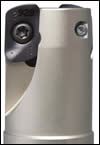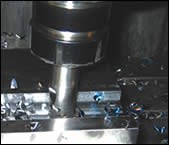High Speed Machining Without The Fast Spindle
Relying on axial chip thinning lets a larger-diameter tool realize some of the benefits of high speed machining even if the machine's spindle speed is low.
Share



Axial chip thinning is a way of “cheating,” sort of, to achieve a higher feed rate. At least it seems like cheating. Under the influence of chip thinning, the chip thickness no longer equals the advance per tooth. Instead, the chip is smaller—meaning the rate of advance per tooth can increase.
A ballnose end mill is the most common tool used to realize this effect. This tool cuts the full chip thickness only at its full radius. When the depth of cut is shallower than that—that is, when the depth of cut doesn’t clear the radius of the ball—chip thinning comes into play. Taking advantage of this effect can allow the machine to achieve a higher feed rate without paying as much of a price in terms of the load on the tool.
Mike Gadzinski, training manager with Iscar, notes that this phenomenon has been known for some time. What is less well known is that a ballnose tool isn’t essential for this effect. A larger tool can do it too. Iscar’s “Feedmill” inserts feature a curved profile designed specifically to take advantage of chip thinning, and these inserts can be used in end mills as large as 1.5 inch in diameter.
A solid-body ballnose end mill requires a high spindle speed to remove material productively. This is true not just because the tool has a smaller nominal diameter, but also because the light cut on the ball means the actual cutting diameter is smaller still. This spindle speed is the reason why axial chip thinning is often associated with high speed machining. The advantage of the larger-diameter inserted tool is that it overcomes this need for speed. A shop can realize some of the benefit of high speed machining on a machine that may be capable of only 8,000 or 10,000 rpm.
The curve of the insert’s cutting profile has a radius of 0.5 inch. Mr. Gadzinski says a new tool body is not necessarily required to take advantage of this insert because one of the company’s existing “Helimill” end mill bodies can be modified to accept it. A user might therefore apply the chip-thinning inserts for high-feed-rate roughing, then replace them with more conventional inserts to mill out any internal corners that the rounded inserts couldn’t reach.
Iscar recently ran tests to evaluate how well axial chip thinning could be used in milling passes where an even larger tool makes the spindle speed quite low indeed. Using conventional inserts, a 4-inch diameter cutter with 8 teeth was able to machine SAE 4340 at 0.06-inch depth of cut and 0.006-inch feed per tooth for a metal removal rate of 3.35 cubic inches per minute. When the inserts were replaced with the chip-thinning inserts, however, the productivity increased by better than a factor of 6. At the same depth of cut, the feed rate increased to 0.04 inch per tool for a metal removal rate of 22.4 cubic inches per minute.
Related Content
-
Tungaloy Milling Inserts Enhance Cutting Performance
TungAluMill is designed for efficient machining of aluminum alloys and other non-ferrous materials at high speeds.
-
SPC Innovations Milling Attachments Boost Productivity
PMTS 2025: SPC Innovations Inc. showcases multispindle attachments that can increase productivity, reduce secondary operations and enable for quick job changeovers.
-
Picking the Right End Mill
Kennametal global product manager Katie Myers explains how cutting tool features can impact machining strategies for different materials.
























